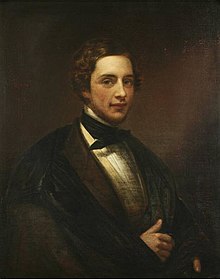Edwin Smith | |
|---|---|
 Portrait of Edwin Smith painted 1847 by
Francesco Anelli, in the collection of the
New-York Historical Society. | |
| Born | 1822 Bridgeport, Connecticut |
| Died | April 27, 1906 (aged 83–84) |
| Nationality | American |
| Occupation(s) | dealer and collector of antiquities |
| Known for | Edwin Smith Papyrus |
Edwin Smith (1822 – April 27, 1906) was an American dealer and collector of antiquities who gave his name to an Ancient Egyptian medical papyrus, the Edwin Smith Papyrus.
Life
Smith was born in Bridgeport, Connecticut, [1] [2] and lived in Egypt during the latter half of the 19th century. In 1862 he came temporarily into possession of a medical papyrus which was sold by its Egyptian owner to Georg Ebers in 1873 and published by Ebers in 1875. [3] It was thus best known as the Ebers Papyrus.
In 1862 he also purchased the papyrus which came to bear his name, the Edwin Smith Papyrus, from a dealer called Mustapha Aga at Luxor. [4] Smith's knowledge of hieratic was not sufficient to enable him to translate the papyrus, a task which was undertaken by James Henry Breasted, aided by Arno B. Luckhardt, a professor of physiology, and led to the publication of the translation in 1930.
Some two months after he purchased the Edwin Smith Papyrus, he was sold a forged papyrus made by gluing miscellaneous papyrus fragments onto a roll. Discovering the forgery, he separated the fragments, some of which belonged to the Edwin Smith Papyrus, and put those into their places in the papyrus. Some of the remaining fragments, traced to the Rhind Mathematical Papyrus, are now kept with the Edwin Smith Papyrus in the Brooklyn Museum. [5]
Edwin Smith died in 1906.
See also
Notes
- ^ Frederick G. Kilgour Journal of the American Society for Information Science, Volume 44, Issue 5 , Pages 292 - 297, 1993.
- ^ Breasted (1922), p.9
- ^ Clagett (1995), p.193
- ^ Breasted (1922), p. 30
- ^ Guggenbühl, Laura (October 1964). Eves, Howard (ed.). "The New York fragments of the Rhind Mathematical Papyrus". Historically Speaking. The Mathematics Teacher. 57 (6): 406–410. doi: 10.5951/mt.57.6.0406. JSTOR 27957095.
References
- Marshall Clagett, Ancient Egyptian Science: A Source Book, vol. II, Calendars, Clocks, and Astronomy, 1995, ISBN 9780871692146.
- James Henry Breasted (editor), The Edwin Smith Surgical Papyrus: Hieroglyphic Transliteration, Translation and Commentary, 1922, New-York Historical Society. Republished in three volumes in 1930 by University of Chicago Press: Volume I; Volume II; and Volume III.
